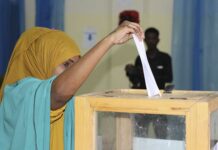Between the deaths of 84 South Africans in the collapse of a building belonging to the Synagogue Church of All Nations (SCOAN) in Nigeria, the devastation in the aftermath to the deadliest floods yet to hit Kashmir, the Scottish referendum on independence, Julius Malema being chucked out of Parliament (again) for calling the deputy president a murderer, and the imminent one-year anniversary of the Westgate Mall attack, it has been by no means a slow news week.
All of these are important to our national conversation, particularly the maddening events in Nigeria, a tragedy made worse by the lack of assistance being offered by the SCOAN church and Nigerian officials to both the people still trapped in the collapsed building and their families.
But it’s hard to ignore the fact that before any of this unfolded, the South African media, including some of the country’s biggest media houses, started the week with front page headlines about minister who’d apparently sworn to defend the president with her buttocks.
Was it a case of willful ignorance that drove reporters to translate a Setswana turn of phrase literally rather than figuratively, even after a spokesperson for the minister explained that the words were meant figuratively? Or did it speak of a more insidious issue?
I can’t help but ask, why is it that whenever a black woman’s buttocks are mentioned, we get our collective knickers in a twist?
Big bottoms may be back in fashion these days (according to some at least) but they’re still subject to double standards.
Although largely ignored by the monied classes, service delivery protests happen every day in South Africa. In June we managed to look up from our cappuccinos just long enough to point at laugh at those who’d decided to drop their trousers in protest of the appalling state of housing provision in Diepkloof.
Service delivery protests are so commonplace in South Africa it seems that they’re only noteworthy – or newsworthy – if they’re blocking roads or bearing bottoms.
Similarly, when a naked woman decided to have a quiet moment with the Nelson Mandela statue in Sandton Square back in July, people couldn’t stop talking about her body hair and again, her big butt. A naked woman wandering about Sandton might be something to behold but why the fixation with her derriere, I ask?
Even the two hapless, racist young UP students who decided to dress up in blackface, sure didn’t miss an opportunity to also pad their butts. It was a “performed stereotype of the black female body†as one commentator put it.
Is it just me, or is there a disturbing pattern here?
One can’t help but notice a disturbing tendency to point and laugh at the black female body. The media is guilty, so is society.
Isn’t it time we grew up?

![Maler der Grabkammer des Horemhab [wikimedia images]](https://www.thedailyvox.co.za/wp-content/uploads/2014/09/Maler-der-Grabkammer-des-Horemhab-wikimedia-images.jpg)







